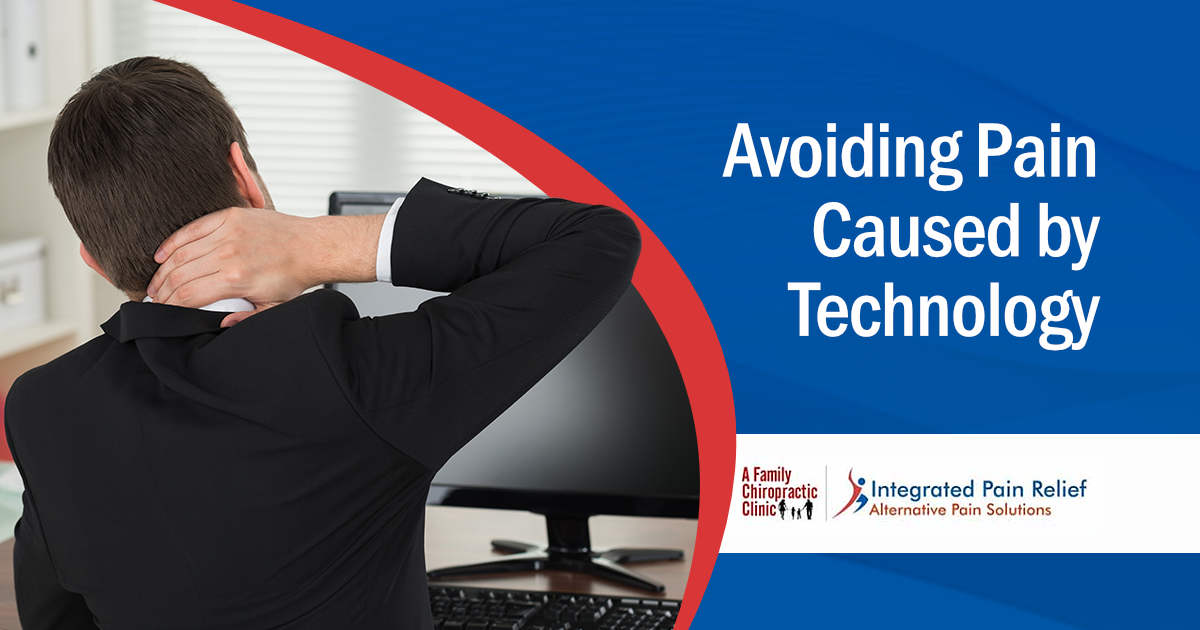Neck pain has increased substantially over the past few decades. Studies have shown that this is largely due to the increase in technology use. Americans have a tendency to spend an extreme amount of time looking down at their cell phones, tablets, and other electronic devices. The consequences of contorting our bodies to see our screens are really stacking up. In fact, doctors have named the distinct posture associated with this action as “text neck.”
The experts at A Family Chiropractic Clinic have seen the increase in neck pain from technology increase first hand. We are treating signs of premature degeneration of the spine in patients much younger than would be expected. In an effort to improve the impact on growing spines, we’ve put together some information for you and your family about what you can do to prevent long term damage.
Neck Pain and Technology
When you tilt your head forward to read or write a text message, play a game on your hand-held device, or update your status on social media you are actually causing damage. Your neck muscles, tendons, and ligaments, must strain to hold your head up in this unnatural position. Technology is proving to be a leading cause in the neck pain that plagues teenagers and young adults. In fact, the physical damage caused by this hunched over position rivals the destruction that is commonly seen in older adults. This means that the damage caused by looking down at technology is the same as what we see after several years of work for welders and dentists.
This is particularly alarming when it comes to the impact on growing bodies. Though your teenager may not admit to having neck pain, the damage from spending hours looking at their hand held device is there. A teenager’s spine is still developing and especially susceptible to damage caused by poor posture. We are now seeing generations developing arthritic changes to their spine as well as muscle deformities and bone spurs.
Research is showing that text messaging is far worse on the neck than other tasks completed on hand held devices. The angle of the head while texting is more extreme than it is when web surfing or watching videos. This has shown true for both standing and seated positions; however texting while sitting is worse. Those who spend most of their day texting in this position are far more likely to experience neck pain and growth problems.
Preventing Neck Pain While Using Technology
Despite all this research, there’s no need to rush to get rid of your cell phone or tablet. There are ways to prevent neck pain and keep the spine healthy and still use technology. The first step in correcting the problem is to fully understand the issue. Your neck muscled are designed to support the weight of your head in a neutral position. The weight of the head is generally 10 to 12 pounds and is no problem when you exercise correct posture. When you look down at your hand held device, you typically do so at about a 60-degree angle. This angle places an incredible 60 pounds of force on your neck. Your neck is not designed to hold this amount of weight over a long period of time.
There are a few actions you can take to help improve your posture and prevent neck pain. Start by raising your hand held device to eye level. This makes it so your head doesn’t have to tilt forward and put extra pressure on your neck. Taking frequent breaks is also important. If you’ve been looking at your hand held device for a while, set it down and do something else for a period of time to give your neck a rest. Changing positions is also a great way to relieve pressure. Try to lay on your back while texting to help support your neck. Standing up straight with your shoulders back will also help keep your body in alignment and reduce the pressure that contributes to neck pain. Staying active helps your neck and back muscles stay strong and flexible, making them better able to handle the extra pressure. Also check out Neck Pain Relief Tips to learn more!
Keeping Your Neck Healthy to Reduce Neck Pain
Maintaining an active life style will help improve blood flow while relieving tension and pain. There are some stretches you can do regularly to help with these things. Begin by tucking your chin down towards your neck before slowly lifting your chin towards the ceiling. Next, turn your head to look over your right shoulder, and then slowly turn it until you’re looking over your left shoulder. Looking forward, rotate your shoulders clockwise with your arms at your side, then repeat counter clockwise.
Any other exercises that engage your back muscles will also help improve posture and body awareness. Activities such as Yoga, Pilates, and dance are all great to help build up strength in your back and help you become more aware of your posture. Understanding the problem and knowing what you can do to minimize the effects is the best way to prevent neck pain.

